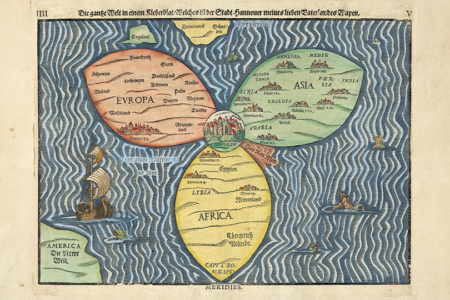The Jewish Mirage
A magazine artist recently wanted to picture a Jew and eventually had to settle for the stereotyped image of a man dressed in a long black coat and a black hat. People have come to expect a real Jew to look like that. If he also wears a beard and side curls, he is often taken to be a rabbi or at least very orthodox. This tendency to “look on the outward appearance” can lead to a great deal of confusion as to what is truly Jewish and what is not. The theatre, graphic artists, and writers have tended to shape the image of the Jew in a way that substitutes a caricature for the real thing. Where would one look for a true picture of genuine Judaism? Where else but the Bible, It is there that we find the “genesis” of the Jewish people, which can be traced from God’s call to Abraham, through the careers of Isaac and Jacob and his sons, and their formation under Moses into a nation. The Bible records, however, the continual struggle which has always gone on between the divine plan for the Jewish people and the insidious influence of the surrounding cultures. This was true even in their own land of Israel, but even more so in the lands of the Jewish dispersion,
This brings us back to the validity or otherwise of the accepted Jewish stereotype. How Jewish is the long black coat, the big black hat and the white socks of the traditional Jewish dress? This costume is nothing more than a relic of Eastern Europe, where many years ago it was the normal dress of a Polish courtier. Yiddish, the language normally spoken by those who wear these clothes, is another testimony to assimilation because it is basically an archaic form of German.
But the point at which stereotyped Judaism is farthest from the basic Judaism of the Bible is in the realm of thought and doctrine. The mystical teaching which forms the doctrinal basis of the Chassidic movement, which at present is seen as the backbone of Orthodox Judaism, is diametrically opposed to true Judaism. When this Chassidic movement emerged in the Eighteenth Century it was denounced as heresy by outstanding Jewish leaders such as the Vilna Gaon.1 The world authority on Jewish mysticism, Gershom G. Schoiem, sees a direct link between Chassidism and its wildly heretical predecessor, Sabbatianism.2 But an even more alarming parallel is to be found between Chassidic thought and Greek Gnosticism.
Those who have studied Gnostic thought are familiar with the strange concept of a female goddess-like principle, Sophia,3 and a fantastic story of a cosmic disaster which results in a scattering of divine sparks throughout the material world. This concept reemerges in Chassidic thought with the divine presence (Shekinah) as the female principle and the divine sparks being scattered through an event known as the “Breaking of the Vessels”.4 The redemption of the world is seen by Chassidism as achievable through the rescuing of these divine sparks (Tikkun) through ritual observance. Thus the observances of Orthodox Judaism are incorporated into an alien scheme which reduces them to an attempt at magical manipulation of the physical world.5 This transposition of traditional concepts and practices, so that they are harnessed to another diametrically opposed system, was the strategy of the Second Century Gnostics, and it led to their exposure by and ejection from the church. In the case of rabbinic Judaism, however, the emphasis on external observance, which is its outstanding characteristic, has caused it to leave its defenses wide open to those who are willing to conform outwardly while retaining their own mystical and alien interpretations of these acts.
When this basic problem in modern Judaism is grasped, it is easier to understand some of the problems which face missionaries and Hebrew Christians. Why is it so difficult to communicate the Gospel to an “orthodox” Jew if that person’s whole life is based on the Old Testament, which so clearly points to Christ? The truth of the matter is that, despite appearances, the struggle is not between Jewish and Christian teaching, but rather between a Gospel which is both Jewish and Christian and a Gnostic philosophy which as neither. Also, the Hebrew Christian who hopes to align himself more fully with his Jewish heritage by taking up Jewish ritual is in for trouble. Where these ritual observances have been given occult overtones, such as when phylacteries are said to “guard”, and mezuzahs are seen as amulets, and ritual fringes are made to conform to occult knot-tying practices, only confusion can result.
There is a sure guide to genuine Judaism, it is not in the Talmud with its 2,000 Greek loan-words, nor in the Zohar with its dubious Second Century authorship,6 nor in the Aristotelian arguments of Maimonides’ Guide to the Perplexed. Rather, it is in the Old Testament, which was written under the providential inspiration of the God of Israel.
This most Jewish of all books points to Jesus, the greatest Jew who ever lived, who is able to make any Jew a completed Jew and make any Gentile a son of Abraham. As that great Jew, Paul, put it,
“For he is not a Jew, which is one outwardly …But he is a Jew, which is one inwardly … in the spirit.. . whose praise is not of men, but of God” Romans 2:28, 29.
ENDNOTE
- I, Epstein, Judaism (London; Penguin Books, 1959); p. 281.
- G. C. Scholem, Major Trends in Jewish Mysticism (London: Thames & Hudson, 1955), p, 333.
- H. Lietzmann, A History of the Early Church (London: Lutterworth Press; 1961), Vol. 1, p. 289.
- Scholem, pp. 305 & 330. (See also Jacobs, L, Hasidic Prayer, Schocken, New York, 1973}.
- Ibid., p, 30.
- ibid., p. 159.







